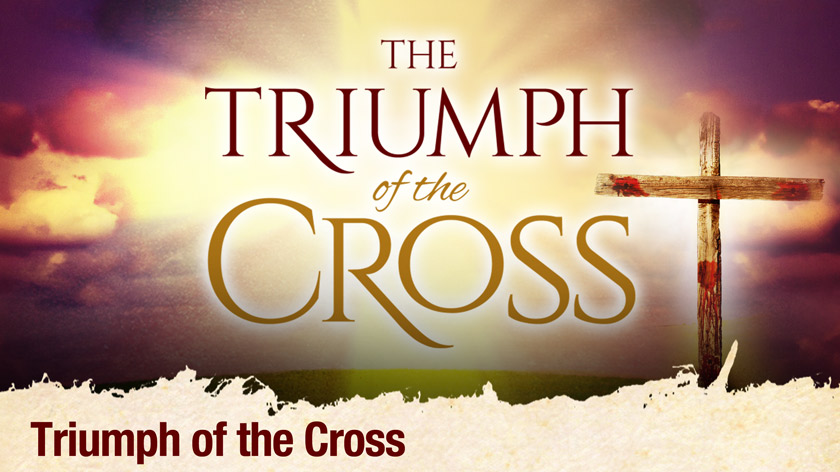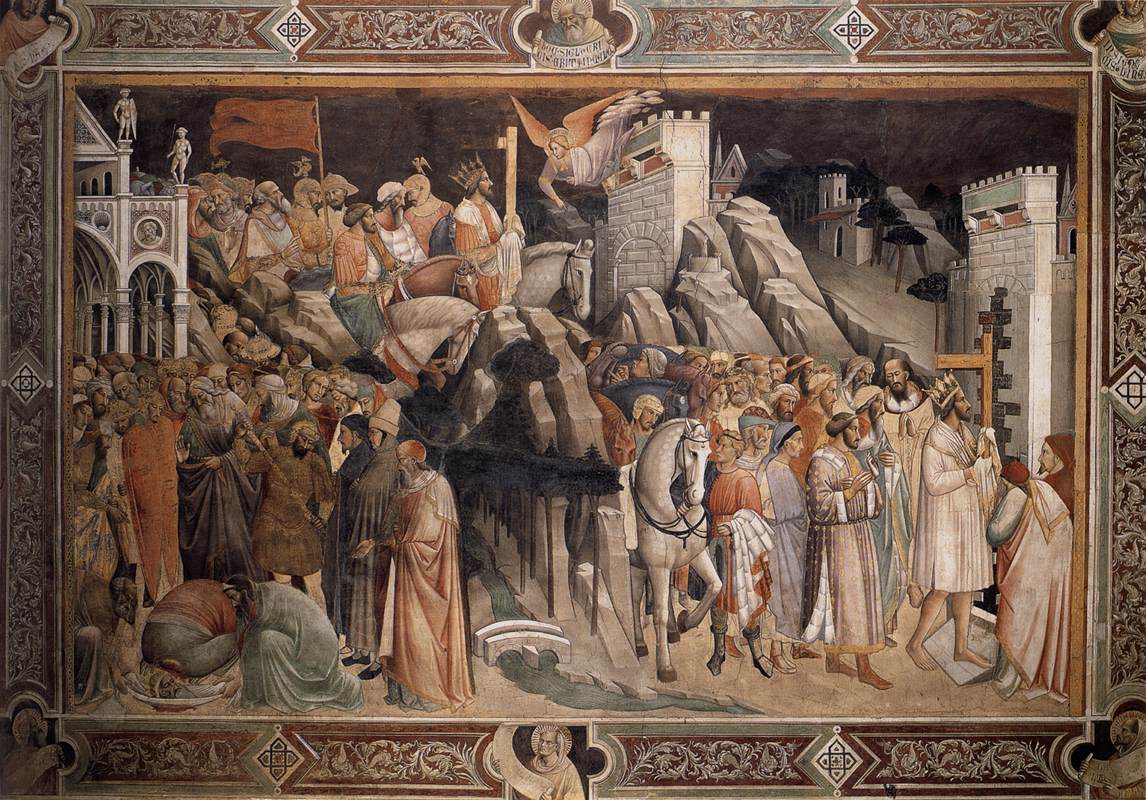
-St. Vincent de Paul Church. Huntington Beach, California
Often in an ecumenical chapel, the crucifix (the moment of our salvation) facing the congregation is turned around displaying a plain cross for Protestant services. The devil in me imagines Jesus turning his back on Protestants. 😉 Mea culpa, mea culpa, mea maxima culpa.

-by Michelle Arnold, Catholic Answers
“The new empress had converted to Christianity the year before and was eager to go on pilgrimage to the Holy Land. Her son, the emperor, although not yet a Christian himself, gave his mother permission to use the imperial treasury to buy up whatever sacred relics she could find during her stay. With that, St. Helena headed off to see the sites of Christ’s earthly ministry, intent on locating what physical relics remained from his public life.
Helena’s most important discovery is reputed to have been the cross on which Christ was crucified. According to traditional accounts, after ordering the destruction of a pagan temple built near Calvary by a previous emperor, Helena had her men excavate the site. There they found three crosses. To determine which one was Christ’s, Helena had a mortally ill woman touch each of the crosses. When the woman was miraculously healed after touching one of them, Helena proclaimed that cross the True Cross.
In honor of his mother’s find, Emperor Constantine ordered a church to be built on the site. That church became known as the Church of the Holy Sepulchre (known by the Orthodox as the Church of the Resurrection). Most Christians believe it to house both Calvary and Christ’s tomb. The first day that the True Cross was brought outside the church for adoration by the faithful, September 14, 335, would become the feast of the Exaltation of the Holy Cross, which we celebrate today.
Protestants often are deeply uncomfortable with Catholic devotion to the crucifix, a sacramental that depicts the corpus (body) of Christ on his cross. They want to know why Catholics don’t simply have empty crosses in their churches, as is the custom in many Protestant churches. After all, they claim, Christ has been raised from the dead. Doesn’t a bare cross better show that he is risen?
Despite their affinity for crosses, many Protestants are also skeptical of the Church’s claim to possess the True Cross and to make relics from that cross available for veneration by the faithful. Not only do they doubt the authenticity of the relics, but some anti-Catholics even scorn the value of the True Cross itself. As the late Bart Brewer wrote:
It is said that if all the pieces of the [true] cross [of Christ] displayed in Catholic churches were assembled together, it would take a ten-ton truck to carry them. It is clear that most “relics” are frauds. Furthermore, there is nothing in the Bible that supports the veneration of relics, even if they are genuine.
So, on the one hand, many Protestants object to crosses that display Christ’s body in favor of bare crosses—and, on the other, they often reject the value of the True Cross itself, even if pieces of it were real. How do we as Catholics answer these objections? The story of how Helena recovered the True Cross may be useful in answering both objections.
As we saw, when Helena and her men excavated the site where Calvary had been located, they found three crosses. Naturally, they assumed that two of the crosses belonged to the two criminals executed with Christ (Matt. 27:38). Not having any interest in the thieves’ crosses, they sought to determine which cross was Christ’s and accepted a miraculous healing as proof of the True Cross.
Bare crosses alone, such as the ones Helena found near Calvary, were of no interest unless she could prove which one of them was Christ’s. The other crosses might have been interesting archaeological finds, but had no lasting value to her.
But even without Christ’s body hanging upon it, the actual cross on which Christ died is sacred because of its relation to him. Think of a throne without a king, a bench without a judge, or the presider’s chair in a church without a priest. Even when not in use, thrones, judicial benches, and presider chairs do have inherent value as symbols of the authority of the one who uses them. In like manner, the True Cross is sacred and worthy of Christian devotion because the one who used it is God himself.
From its beginning, the Church has reverenced the image of Christ on his cross and has considered the manner in which Christ died to be an integral part of the gospel. St. Paul wrote:
For since, in the wisdom of God, the world did not know God through wisdom, it pleased God through the folly of what we preach to save those who believe. For Jews demand signs and Greeks seek wisdom, but we preach Christ crucified, a stumbling block to Jews and folly to Gentiles, but to those who are called, both Jews and Greeks, Christ the power of God and the wisdom of God (1 Cor. 1:21–24, emphasis added).
The Catechism of the Catholic Church notes that we do not merely preach Christ’s resurrection but the resurrection of the one who was crucified, which acts as a confirmation of the divinity of God the Son:
The truth of Jesus’ divinity is confirmed by his resurrection. He had said: “When you have lifted up the son of man, then you will know that I am he.” The resurrection of the crucified one shows that he was truly “I AM,” the Son of God and God himself (653, emphasis added).
When Protestants ask why Catholics use a crucifix instead of a bare cross, the answer then is twofold. We don’t separate Christ’s body from his cross because we value both his body and his cross. God the Son died as man to save the world, which means that his human body is sacred and worthy of our worship. And since he chose to die by crucifixion, the cross on which he died is worthy of our veneration because that was the means by which he saved the world. A bare cross has no value unless it is clearly his cross. As Paul said:
Far be it from me to glory except in the cross of our Lord Jesus Christ, by which the world has been crucified to me, and I to the world (Gal. 6:14).
And not only does the cross attain value by its relation to Christ—we too can become distinguished by our connection to the cross. Have you ever seen an icon or holy card of Helena? In practically every image created of her, iconographers and artists render her as holding a cross. That’s because Helena is most readily identified by Christians not by her relationship to her son the emperor, but by her relationship to Christ and his cross.
Today’s feast commemorates not just the death of Christ (as does Good Friday) but invites us to venerate the Cross itself, by which He redeemed the world.”
Love, Jn 19:30,
Matthew





